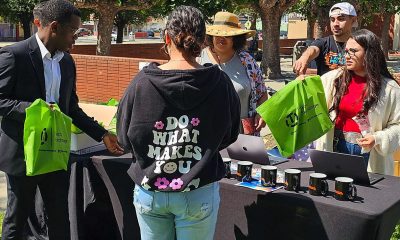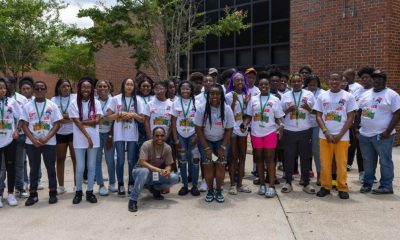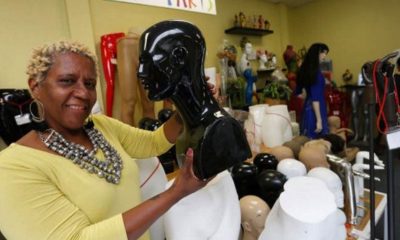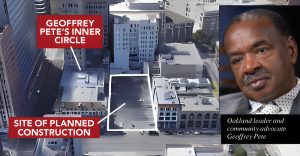Technology
Lenovo Shipped Laptops with Security Flaw, Experts Say
BRANDON BAILEY, AP Technology Writer
SAN FRANCISCO (AP) — If you’ve recently purchased a laptop computer made by Lenovo, you may want to hear this: Experts say the world’s biggest computer maker shipped laptops with pre-installed software that could let hackers steal passwords or other sensitive information when you use the web to shop, pay bills or check email.
Lenovo said Thursday that it has disabled the offending software, known as Superfish, and will provide customers with a tool that permanently removes the program from their computers. The company initially said its own investigation didn’t find “any evidence to substantiate security concerns.” But it later removed that sentence from a statement on its website.
The problem affects an unknown number of computers: Lenovo said it shipped “some” laptops with Superfish between September and December last year, before it stopped because of customer complaints. That could cover a large number of machines. Lenovo shipped more than 16 million laptop and desktop machines in the fourth quarter.
Superfish wasn’t intended as malware. Lenovo has said it was designed to show targeted ads by analyzing images of products that a user might see on the web and then presenting “identical and similar product offers that may have lower prices.” Lenovo said the software doesn’t track users or collect any identifying information.
But some users initially complained the software shows unwanted “pop-up” ads. And this week, several independent experts reported that Superfish works by substituting its own security key for the encryption certificates that many websites use to protect users’ information. “This means that anyone affected by this adware cannot trust any secure connections they make,” researcher Marc Rogers wrote on his blog.
What’s worse, experts said, is that Superfish appears to re-use the same encryption certificate for every computer, which means a hacker who cracked the Superfish key could have broad access to a variety of online transactions. Robert Graham, chief executive of Errata Security, boasted in a blog post Thursday that he was able to figure out the Superfish encryption password in a few hours.
So far, there’s been no evidence that hackers have used the vulnerability to steal information. To do that, some experts said, a hacker would probably need to search for owners of laptops that have the Superfish software and are using a public Wi-Fi connection to visit secure websites.
But some critics blasted Lenovo for acting irresponsibly by installing the software. “Lenovo has not just injected ads in a wildly inappropriate manner, but engineered a massive security catastrophe for its users,” said the Electronic Frontier Foundation, an Internet advocacy group, in a blog post Thursday.
Superfish is made by a tech startup based in Silicon Valley and Israel. A spokesperson wasn’t immediately available for comment.
Many PC-makers ship computers with pre-loaded software from other companies, often in exchange for commissions or fees. Lenovo said its arrangement with Superfish is “not financially significant.” The company said it stopped selling laptops with the program in January and added: “Our goal was to enhance the experience for users; we recognize that the software did not meet that goal and have acted quickly and decisively.”
“We’re not claiming it wasn’t a mistake,” Lenovo spokesman Brion Tingler added Thursday. “We do due diligence and it wasn’t good enough in this case.” He added that the company is reviewing its procedures.
While Lenovo says it stopped shipping computers with Superfish in January, some may still be in stock at retailers. Lenovo posted detailed instructions for removing the software and the Superfish encryption certificate from its computers. They can be found at: http://news.lenovo.com/images/20034/remove-superfish-instructions.pdf
Copyright 2015 The Associated Press. All rights reserved. This material may not be published, broadcast, rewritten or redistributed.
Community
Advanced Conductors Provide Path for Grid Expansion
Utility companies in the United States could double electric transmission capacity by 2035 by replacing existing transmission lines with those made from advanced materials, according to a new study published Monday in the Proceedings of the National Academy of Sciences.

By Matthew Burciaga
UC Berkeley News
Utility companies in the United States could double electric transmission capacity by 2035 by replacing existing transmission lines with those made from advanced materials, according to a new study published Monday in the Proceedings of the National Academy of Sciences.
Led by Duncan Callaway, professor and chair of the Energy and Resources Group (ERG), and Amol Phadke, an affiliate and senior scientist at the Goldman School of Public Policy, the first-of-its-kind study details a faster and more cost-effective way to expand the grid and connect the more than 1,200 gigawatts of renewable energy projects awaiting approval. The analysis was first published last December as a working paper by the Energy Institute at Haas and has been covered by the New York Times, the Washington Post, Heatmap News, and other news outlets.
“Expanding transmission capacity is critical to decarbonization, and we sought to study ways to build it faster and cheaper,” said Callaway.
It currently takes 10 to 15 years to build a new power line and the U.S. is building transmission lines at a lower rate than it was in the past decade. Without sufficient capacity, renewable energy projects often sit in limbo for years as transmission operators study what upgrades—if any—are needed to accommodate the increased loads.
The authors modeled various scenarios to determine if replacing existing transmission conductors with those made with advanced composite-core materials—a process known as reconductoring—could provide a pathway to faster grid expansion.
Several reconductoring projects have been initiated in Belgium and the Netherlands, and utility companies in the U.S. have used the material to string transmission lines across wide spans like river crossings. That technology, however, has not made its way to the majority of overhead power lines that feed residential and commercial customers.
“As we learned more about the technology, we realized that no one had done the detailed modeling needed to understand the technology’s potential for large-scale transmission capacity increases,” said Phadke.
Based on the authors’ projections, it is cheaper—and quicker—for utility companies to replace the 53,000 existing transmission lines with advanced composite-core materials than it is to build entirely new transmission lines.
They assert that doing so would reduce wholesale electricity costs by 3% to 4% on average—translating to $85 billion in system cost savings by 2035 and $180 billion by 2050.
“The level of interest we’ve received from federal and state agencies, transmission companies and utilities is extremely encouraging, and since our initial report, the Department of Energy has committed hundreds of millions of dollars to reconductoring projects,” said co-author Emilia Chojkiewicz, a PhD student in ERG and an affiliate of the Goldman School of Public Policy. “We are looking forward to learning about these projects as they unfold.”
Additional co-authors include Nikit Abhyankar and Umed Paliwal, affiliates at the Goldman School of Public Policy; and Casey Baker and Ric O’Connell of GridLab, a nonprofit that provides comprehensive technical grid expertise to policy makers and advocates.
Black History
A Life of Inventions: Engineer and Physicist George Alcorn
George Edward Alcorn Jr. was born on March 22, 1940, in Indianapolis. Growing up in a family that valued education, Alcorn developed an early love for science and mathematics. He excelled in school, and attended Occidental College in California, where he earned a bachelor’s degree in physics in 1962. He received a master’s degree in nuclear physics in 1963 and a Ph.D. in atomic and molecular physics in 1967 at Howard University.

By Tamara Shiloh
George Edward Alcorn Jr. was born on March 22, 1940, in Indianapolis.
Growing up in a family that valued education, Alcorn developed an early love for science and mathematics. He excelled in school, and attended Occidental College in California, where he earned a bachelor’s degree in physics in 1962. He received a master’s degree in nuclear physics in 1963 and a Ph.D. in atomic and molecular physics in 1967 at Howard University.
Alcorn began his career in developing scientific technology in private industries, starting a career as a physicist for IBM. His career took off when he joined several prestigious companies and research institutions, such as the Aerospace Corporation, where he developed important technologies for spacecraft. In 1978, he accepted a position at NASA’s Goddard Space Flight Center, where he worked for the remainder of his career. There, he developed technologies for space stations and private institutions across the nation, becoming a key figure in the field of physics and space exploration.
Alcorn is well known for his groundbreaking work on X-ray spectrometers. An X-ray spectrometer is a device used to identify different elements in materials by analyzing the X-ray wavelengths they emit. His improvements allowed the instrument to detect X-rays with greater accuracy and efficiency. This invention has been critical for NASA’s space missions, aiding in the analysis of planetary atmospheres and surfaces, including Mars and other planets in our solar system.
He also contributed to the development of plasma etching, a process used in manufacturing microchips for computers and electronics. His work in this area advanced semiconductor technology, which powers everything from smartphones to satellites.
Another accomplishment was the development of new technologies used in the Freedom space station in partnership with space agencies in Japan, Canada and Europe, though their projects never made it to space.
Throughout his career, Alcorn received several awards and honors, including NASA’s Inventor of the Year Award in 1984. In 2010, he received the highest honor from NASA’s Goddard Space Flight Center. In 2015, Alcorn was inducted into the National Inventors Hall of Fame for his invention of the imaging X-ray spectrometer.
In addition to his work in the lab, Alcorn dedicated much of his time to teaching and mentoring young scientists. As one of the few African American scientists working in advanced fields like physics and space exploration, he has been an inspiration to young people, especially those from underrepresented groups in STEM (science, technology, engineering, and mathematics). He taught at Howard University and worked to encourage more African Americans to pursue careers in science and engineering.
George is quoted as stating, “The big thing about being in science and engineering is that if you have a good, interesting project going, work is not coming to work, it’s coming to an adventure.”
George Edward Alcorn passed away June 19, 2024.
Antonio Ray Harvey
Gov. Newsom Touts California Economic Success
In a 20-minute interview on Oct. 10, Gov. Gavin Newsom said California’s economy is in great shape due to achievements in certain areas. The Governor was speaking at the 2024 California Economic Summit event hosted by California Forward in Sacramento. It was attended by more than 100 leaders from industry, community, and the private, public, and nonprofit sectors.

By Antonio Ray Harvey
In a 20-minute interview on Oct. 10, Gov. Gavin Newsom said California’s economy is in great shape due to achievements in certain areas.
The Governor was speaking at the 2024 California Economic Summit event hosted by California Forward in Sacramento. It was attended by more than 100 leaders from industry, community, and the private, public, and nonprofit sectors.
“It is an exciting and dynamic time,” said Newsom. “Thirty-two of the top 50 AI companies are all here in California. We dominate in tourism – record breaking tourism last year.”
“It isn’t by accident that California is an economic powerhouse,” Newsom continued. “Whether it be around education, infrastructure, or immigration, we’re following a formula for success.”
In Newsom’s overview of the state’s economy, he didn’t include why two companies decided to leave for the state of Texas. SpaceX and Chevron announced their departures over the summer.
Billionaire Elon Musk is moving the headquarters of his companies X and SpaceX from San Francisco to Texas. After 140 years of doing business in California, Chevron is heading to the southwestern state as well.
Chevron employs 2,000 workers in San Ramon. It operates crude oil fields, technical facilities, two refineries, and services more than 1,800 retail stations in California.
“There will be minimal immediate relocation impacts to other employees currently based in San Ramon. The company expects all corporate functions to migrate to Houston over the next five years. Positions in support of the company’s California operations will remain in San Ramon,” Chevron shared in an Aug. 2 press release.
-

 Alameda County5 days ago
Alameda County5 days agoAlameda County District Attorney Pamela Price Announces $7.5 Million Settlement Agreement with Walmart
-

 Activism3 weeks ago
Activism3 weeks agoCOMMENTARY: DA Price Has Done Nothing Wrong; Oppose Her Recall
-
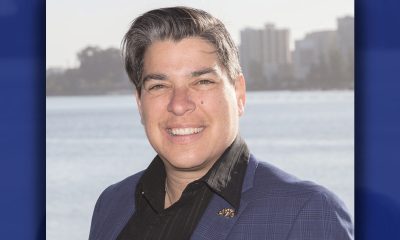
 Activism2 weeks ago
Activism2 weeks agoOP-ED: Hydrogen’s Promise a Path to Cleaner Air and Jobs for Oakland
-

 Activism3 weeks ago
Activism3 weeks agoBarbara Lee, Other Leaders, Urge Voters to Say ‘No’ to Recalls of D.A. Pamela Price, Mayor Sheng Thao
-

 Community2 weeks ago
Community2 weeks agoTerry T. Backs Oakland Comedy Residency by Oakland’s Luenell at Jimmy Kimmel’s Comedy Club in Las Vegas
-

 Activism3 weeks ago
Activism3 weeks agoOakland Post: Week of October 9 – 15, 2024
-

 Business2 weeks ago
Business2 weeks agoStudy Confirms California’s $20/Hour Fast Food Wage Raises Pay Without Job Losses
-

 Bay Area2 weeks ago
Bay Area2 weeks ago2024 Local Elections: Q&A for Oakland Unified School Candidates, District 3







